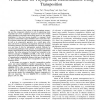Free Online Productivity Tools
i2Speak
i2Symbol
i2OCR
iTex2Img
iWeb2Print
iWeb2Shot
i2Type
iPdf2Split
iPdf2Merge
i2Bopomofo
i2Arabic
i2Style
i2Image
i2PDF
iLatex2Rtf
Sci2ools
BIBE
2007
IEEE
2007
IEEE
A Heuristic for Phylogenetic Reconstruction Using Transposition
Abstract—Because of the advent of high-throughput sequencing and the consequent reduction in cost of sequencing, many organisms have been completely sequenced and most of their genes identified; homologies among these genes are also getting established. It thus has become possible to represent whole genomes as ordered lists of gene identifiers and to study the evolution of these entities through computational means, in systematics as well as in comparative genomics. As a result, gene order data (also known as genome rearrangement data) has attracted increasing attention from both biologists and computer scientists as a new type of data for phylogenetic analysis. Methods for reconstructing phylogeny from genome rearrangements include distance-based methods, MCMC methods and direct optimization methods. The latter, pioneered by Sankoff and extended in the software packages of GRAPPA and MGR, is the most accurate approach for inversion phylogeny. However, due to the difficulty of com...
| Added | 02 Jun 2010 |
| Updated | 02 Jun 2010 |
| Type | Conference |
| Year | 2007 |
| Where | BIBE |
| Authors | Feng Yue, Meng Zhang, Jijun Tang |
Comments (0)

